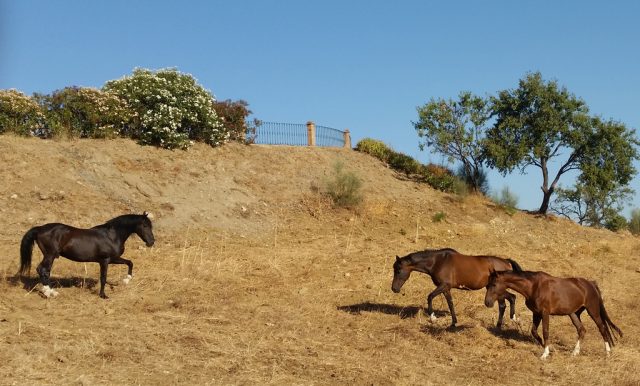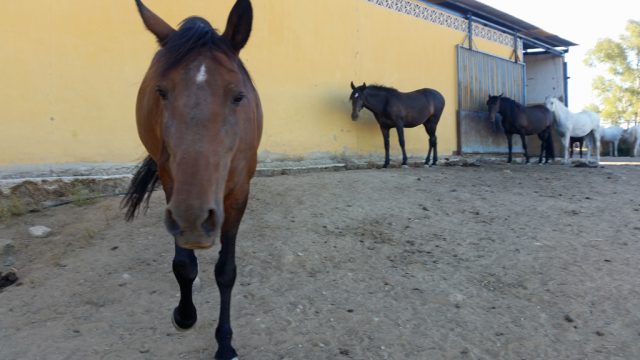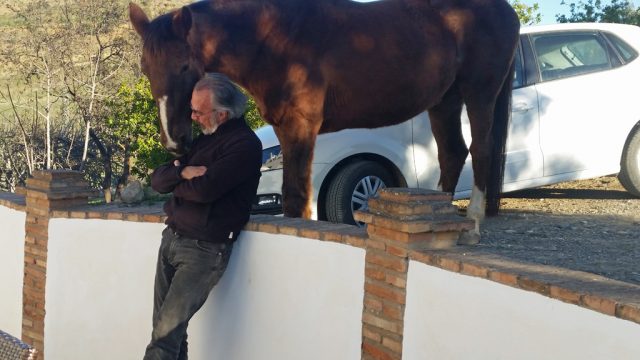 When all is said and done, I truly believe that this is the litmus test of a human’s ability to be fully human with their horse. And it is simultaneously the lesson that encompasses all of the others. If all of us could do this with our horses, how much more fulfilling would their lives not be? (Taken from “Lessons Taught Me by My Horse” in the book, When Horses Speak and Humans Listen. For more information see http://www.horsesandhumans.com/mainsite/whsahl.htm.)
When all is said and done, I truly believe that this is the litmus test of a human’s ability to be fully human with their horse. And it is simultaneously the lesson that encompasses all of the others. If all of us could do this with our horses, how much more fulfilling would their lives not be? (Taken from “Lessons Taught Me by My Horse” in the book, When Horses Speak and Humans Listen. For more information see http://www.horsesandhumans.com/mainsite/whsahl.htm.)
So what would it take to become the kind of human whom a horse seeks to be with? Would you need to become an enlightened leader? This is a question that I raised in my article entitled Horses and the Art of Followership and this is more or less what I wrote at the time.
An ideal concept of leadership
If you were to ask a fairly enlightened human to provide you with the definition of a “leader”, you may be presented with something of this nature: a leader is someone who is capable of exhibiting empathy, who is trustworthy and empowering, who sets an example, who is charismatic, and who inspires, motivates, encourages, and ultimately liberates. Let us assume for a moment that you actually manage to become someone who fits this description….
(Taken from “Horses and the Art of Followership” in the book, When Horses Speak and Humans Listen. For more information see http://www.horsesandhumans.com/mainsite/whsahl.htm.)
So, if you were capable of being such a leader, would a horse want to follow you or even just seek to be with you? What follows is what I wrote in answer to this very question in the same article.
Reasons to follow
The chances are that your horse would not choose to follow you, even if you possessed all of the qualities that would make you the most enlightened leader the world has ever seen. Why not? To answer this question we need to examine why horses choose to follow others of their own species.

Friends for years now, Anaïs and Pip (walking on the right) CHOOSE to be with Pingo (standing on the left).
Essentially, there are two main reasons why one horse will choose to follow another. One of these is friendship but not as an enlightened human might care to define it. Truly, it is far more basic. It is feeling. It is bonding through the gut. Unfortunately, our awareness of friendship amongst horses is largely based on our observations of domestic rather than wild or feral horses. As Lucy Rees has noted, ethological studies have largely focused on agonistic (conflict-related) behaviour amongst wild horses rather than affiliative (companionship-related) conduct (see Epona.TV: https://epona.tv/bonding-behaviour-largely-ignored-by-scientists – consulted 20 July 2017). There are some things which science cannot explain and friendship is one of them. Essentially, as I experience it with horses and my best friend and partner, friendship is an energetical and emotional confluence of two life forces, which can become more important to the creatures involved than even food. Indeed, they will even risk safety and security to be with each other. So too with horses
Then there is that special form of friendship which also involves a sexual relationship. As I write this, we are three weeks down the track from a reunion between our mares, Pip and Anaïs, on the one hand, and Pingo, a gelding who was castrated late and still behaves like a stallion right down to recruiting his own harem band within a herd of a little under forty horses within 24 hours, the only time I have ever seen anything like this occur amongst domesticated horses (see my blog post entitled Nature, Riding and the Bottom Line for more details). Although Pip and Anaïs have been close friends for years now, Pip is in season and she constantly leaves her female companion to go in search of her male lover. While the relationship between Pip and Pingo is largely sexual at present, there is a great deal of tenderness and caring in the way they interact with each other. Amongst other forms of endearment, they brush their muzzles against various parts of each other’s body, spend time standing close together even to the point of touching, rest the underside of their heads on each other’s necks and gently rub up and down each other’s mane….

Main attraction, Pingo (centre rear), with his band of mares, who stayed with him but followed other mares to resources.
Secondly, there is a collection of reasons why one horse will choose to follow another and they have everything to do with equine well-being. Here I am referring to those which serve to help the horse feel safe, secure and content. Horses choose to follow other horses to escape danger, find food and water and enjoy each other’s company in natural surroundings, and so forth. In other words, any kind of movement which a trusted horse makes in a direction that makes sense to other senior members of the band is likely to result in them choosing to follow that horse with the foals, adolescents and the stallion taking up the rear.
(Taken from “Horses and the Art of Followership” in the book, When Horses Speak and Humans Listen. For more information see http://www.horsesandhumans.com/mainsite/whsahl.htm.)
The kind of human a horse seeks to be with
So what qualities does a human need to have, if a horse is to seek to be with them? Perhaps the very first is acceptance on the part of a human of something which humans find difficult, if not sometimes impossible, to accept, namely, that the horse needs to have a choice as far as possible. This is not about “leadership” on the part of the human but about “followership” on the part of the horse. It is the horse (and NOT just the human) that gets to CHOOSE whether to be with the human or not.
If the way in which horses interact with each other can point us in the right direction, then clearly we also need to become the kind of human who possesses the qualities that draws one horse to another, that is a human who is first of all capable of offering friendship, the way horses do: sharing space and time with each other while eating, grooming, having fun, engaging in exercise, relaxing and just hanging out, always without expectation. In addition, we need to be able to offer the horse the very same qualities which induce them to choose to follow another of their kind because it is in the interests of their well-being, namely safety, security and the wherewithal to live and enjoy life. In short, we need to be trustworthy, reliable and full of the joy of life.
So what do we need to do to become such a human and how do we do it? I have started writing a book on this very subject and, as I continue, I would like to share some of my ideas with you in the Horses and Humans blog based on what I have come to experience with my horses. Perhaps you will choose to walk and talk with me a while on this journey?

Esperanza, suspicious of humans but still seeking contact with one or two members of the species. You can read her story here: http://horsesandhumans.com/blog/2016/09/02/esperanza-and-the-challenge-of-being/




Very interesting.
I am interested in relationship and the way horses communicate with one another and with us. Thank you for sharing. M
Hi Malcolm
We clearly have common interests. To this I would add that I am particularly interested in exploring how we can influence that relationship and our communication by working on ourselves rather than the horse.
Be well!
Andrew